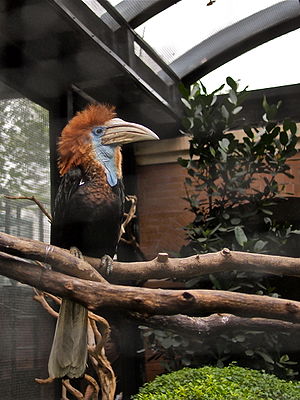- Yellow-casqued Wattled Hornbill
-
Yellow-casqued Wattled Hornbill 
At Hong Kong Zoological and Botanical Gardens Conservation status Scientific classification Kingdom: Animalia Phylum: Chordata Class: Aves Order: Coraciiformes Family: Bucerotidae Genus: Ceratogymna Species: C. elata Binomial name Ceratogymna elata
(Temminck, 1831)The Yellow-casqued Wattled Hornbill (Ceratogymna elata), also known as the Yellow-casqued Hornbill, is found in the rainforest of coastal regions of West Africa, for example in Côte d'Ivoire.
The Yellow-casqued Wattled Hornbill is one of the largest birds of the West African forest, with adults weighing up to 2 kg. They live mainly in the forest canopy, feeding on the ground only rarely. They live in small family groups containing at least one adult male and female, with one or two immature birds, though they sometimes gather in larger flocks to exploit a major food supply such as an ant or termite nest.
The birds are occasionally preyed upon by Crowned Hawk-eagles, and they respond to the presence of an eagle (sometimes indicated by its characteristic shriek) by mobbing, i.e. approaching it and emitting calls. Since the eagles depend on surprise to make a catch, this frequently causes them to leave the area. Recent research (Rainey et al., 2004) has shown that the birds respond in the same way to the alarm calls that Diana Monkeys, which live in the same areas, emit if they notice an eagle, and furthermore that they are able to distinguish the calls made by the monkeys to the presence of eagles from those they make in the presence of leopards, which prey on the monkeys but not on the hornbills.
Biologist Olivia Judson has remarked that "Yellow-casqued hornbills remind me of aging rock stars: their head feathers have that kind of wild look." [1]
References
- BirdLife International (2004). Ceratogymna elata. 2006. IUCN Red List of Threatened Species. IUCN 2006. www.iucnredlist.org. Retrieved on 11 May 2006. Database entry includes a brief justification of why this species is near threatened
- Rainey, H. J., Zuberbühler, K., & Slater, P. J. B. (2004). Hornbills can distinguish between primate alarm calls. Proceedings of the Royal Society of London Series B, 271, 755-759.
- ^ ‘Leopard Behind You!’ by Olivia Judson, NY Times, October 6, 2009. She also comments on hornbill reactions to alarm calls in this article.
Categories:- IUCN Red List near threatened species
- Ceratogymna
- Animals described in 1831
Wikimedia Foundation. 2010.

